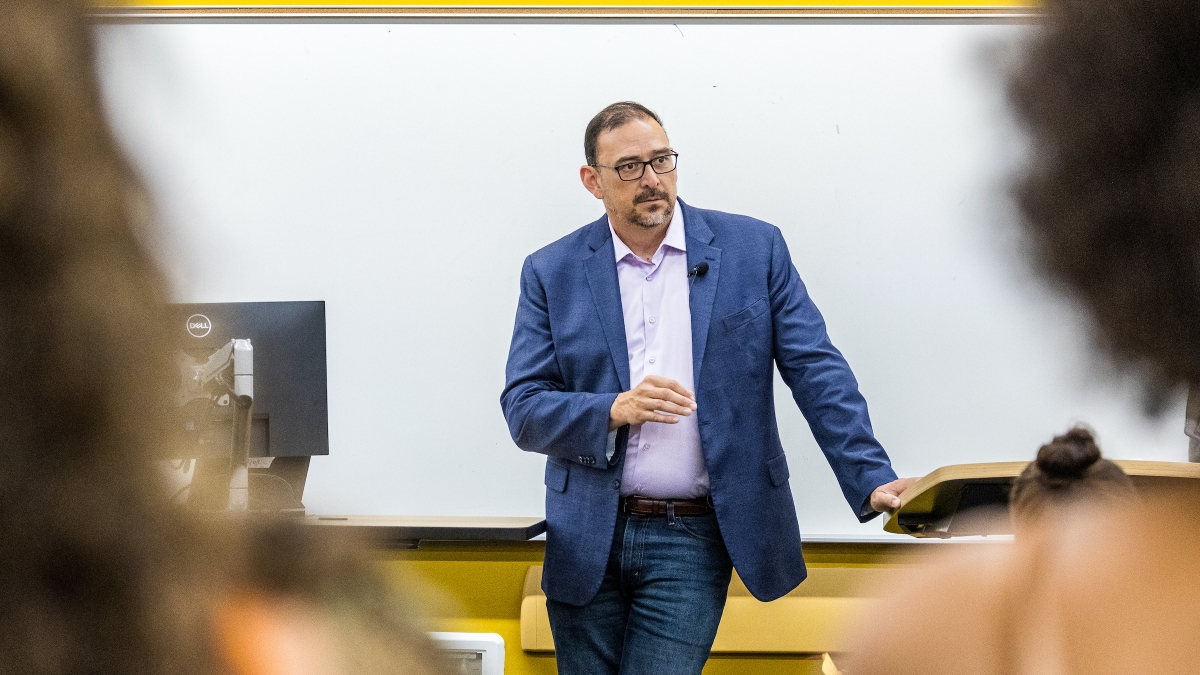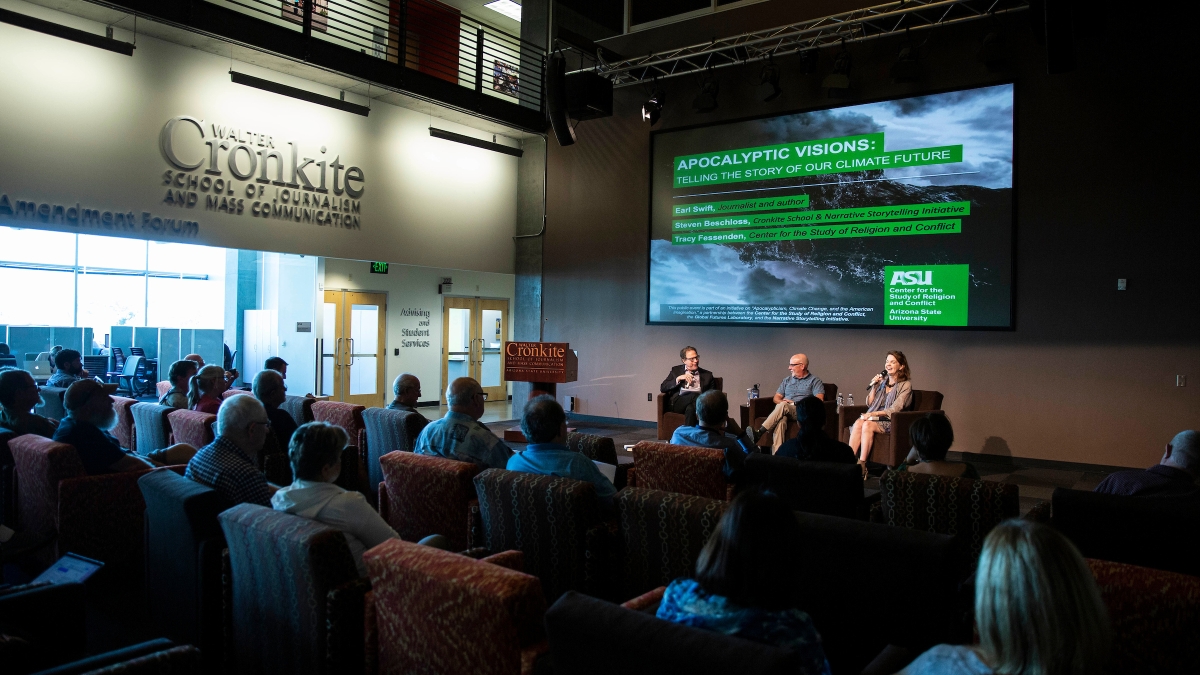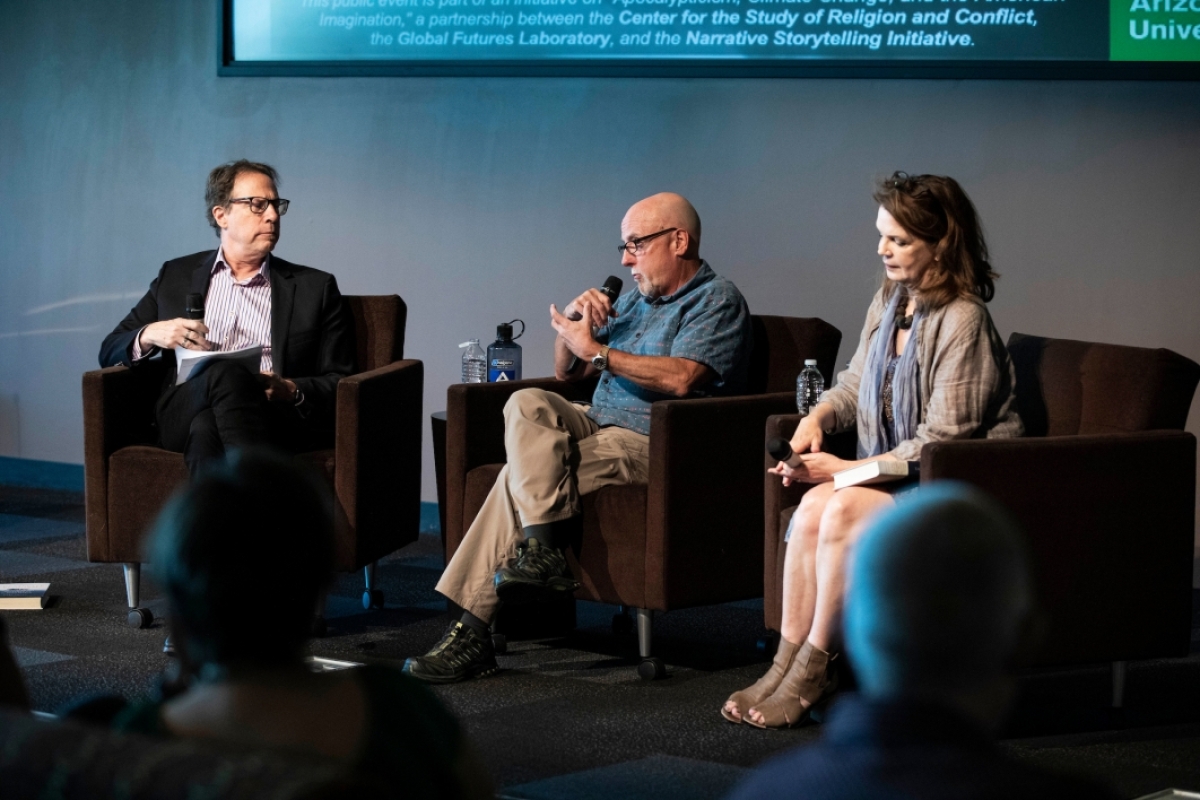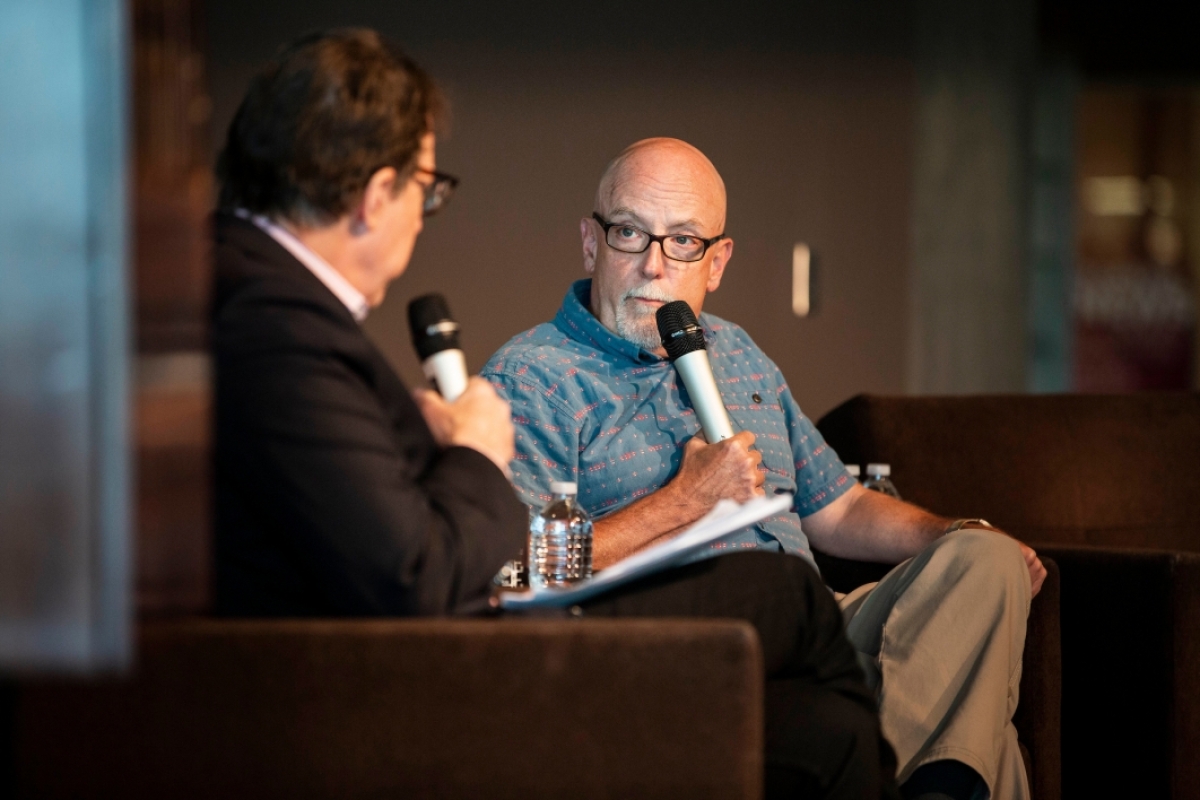A lot had changed in the 15 years since Earl Swift last set foot on Tangier Island, located in Virginia’s Chesapeake Bay. Whole swaths of coastline he’d traversed as late as 2000 had completely disappeared by the time he returned in 2015.
“I was struck by just how profound the change was to the landscape,” Swift, an acclaimed journalist, said Wednesday at a panel discussion on Arizona State University’s Downtown Phoenix campus to discuss his book, “Chesapeake Requiem.”
The public event was part of an initiative on “Apocalypticism, Climate Change, and the American Imagination,” a partnership between the Center for the Study of Religion and Conflict, the Global Futures Laboratory and the Narrative Storytelling Initiative.
Swift was inspired to write “Chesapeake Requiem” because of Tangier Island’s unique predicament: It is likely to become the first U.S. town to succumb to the effects of climate change, with its shoreline retreating at a rate of 15 feet per year, yet its conservative and deeply religious residents are loath to acknowledge mankind’s role in the rising sea levels, interpreting the situation instead as part of a divine, natural cycle.
“There are elements behind the science of climate change that they have a difficult time theologically buying into,” Swift said. “The island is also sinking, which is a byproduct of the last ice age. And if you believe Earth was only created 6,000 years ago, science that directly counters that is tough to swallow.”
He called Tangier Island a “bizarre” place, which is likely why it has been a popular subject for newspapers and magazines for more than a century. Settled during the American Revolution by fundamentalist Methodists, the island has always been a place apart. Today it totals less than 740 acres, only 83 of which are habitable, and roughly 460 people, who speak a distinct language Swift describes as a variation of the Hoi Toider dialectHoi Toider, or High Tider, is a dialect of American English spoken in very limited communities of the South Atlantic United States that can be traced back to influences from 17th-century English..
“It’s 100 miles from (Washington) D.C., yet it’s one of the most isolated communities on the eastern coast,” he said. “It’s a strange little community lost in time that is so close to the bustling Eastern Seaboard but completely separate from it.”
As a journalist living in Norfolk, Virginia, Swift was often sent to Tangier on assignment, but only to cover stories about the quaintness of life or the characters who lived there — never anything to do with climate change. That didn’t stop the islanders from broaching the subject themselves, though.
“I very quickly came to understand that they faced an existential dilemma,” he said. “They were losing eight acres a year on an island that wasn’t that big to begin with. I could sense a low-grade anxiety that ran through the population that has sharpened considerably since then.”
That anxiety was no doubt induced by the rapid changes islanders witnessed firsthand. Swift remembers one local, a 41-year-old man, who took him out on a boat to show him areas of the island where he’d played as a teenager, now 200 yards offshore. Despite what they are able to see with their own eyes, Swift said, the islanders’ faith plays a huge role in their steadfast belief that there is nothing they can do about it — except pray.
Over Tangier’s long history, it has been pummeled by hurricanes — including Sandy in 2012 and Isabel in 2003 — wracked with disease and tested by a number of other tribulations. Each time, the islanders prayed for survival, and each time, they believed their prayers were answered.
“It always worked out, so they came to see themselves as anointed by God, in a way, as separate and distinct from other Americans,” Swift said. “A people apart.”
And even though he listened as they spoke to him of concerns like whether to bother repairing a boat when the amount of time they have left on the island is uncertain, Swift said their resolve was unwavering: “I think they have great faith their prayers will again be answered and there will be intervention on their behalf.”
While writing “Chesapeake Requiem,” Swift estimates he spent four to seven hours a week in church with the islanders. He wanted to better understand them in order to better tell their story, and in a community in which “faith pervades everything,” church was the place to do that.
According to religious studies Professor Tracy Fessenden, it worked. She called Swift’s book a “deeply respectful and loving portrait of the men and women of Tangier Island.”
Fessenden joined Swift at the panel discussion Wednesday, along with moderator Steven Beschloss, senior director for narrative development with ASU Media Relations.
As participants in the “Apocalypticism, Climate Change, and the American Imagination” initiative, both Fessenden and Beschloss contend that narrative has the power to transform ways of thinking, bridge divides and spur change.
Fessenden’s father was a geologist who studied erosion in coastal communities.
“He had a sense of the majesty of geological time that reminded me a little bit of the folks on Tangier,” she said. “(In the book there are) images of gravestones being washed out to sea and there’s this sense that time and the elements mock even our attempts to memorialize ourselves.”
Even so, the islanders would most likely have met Fessenden’s father with a good deal of skepticism.
“I think for many on the island, climate change is a redescription of their reality, and one that doesn’t necessarily help because it doesn’t include a solution,” Fessenden said. And many are deeply critical of the islanders because of that.
“Chesapeake Requiem” briefly relays a 2017 incident in which the mayor of Tangier Island appeared on CNN's climate change town hall with Al Gore, disputing Gore’s assertion that the island’s loss of land was due to rising sea levels, but was instead due to erosion and calling for a sea wall. Gore then recounted a joke many islanders deemed disparaging to their faith because the punchline is a man trapped in floodwaters who refuses aid from rescuers in favor of divine intervention, only to learn from God later that he was the one who sent the rescuers.
Viewers' responses to the Tangier man that flooded the comment section after the segment aired were nothing short of belittling. Swift, Fessenden and Beschloss agreed, that kind of reaction gets us nowhere. However, the kind of storytelling Swift does in his book can.
“This book is … a very patient, intricate, beautiful read of a culture,” Fessenden said. “This kind of attention paid to communities and positions we don’t understand very well … that is the kind of work that’s going to be most effective.”
“You have to have a human face in the story you tell,” Swift said. “Abstract rarely moves to action.”
Paying attention to the language you use also helps.
“The language of climate change is the language of the left, which most on the island of Tangier feel alienated from,” said Fessenden, adding later in the discussion that “it doesn’t speak to their experience,” and that we should think about “enriching, broadening and changing the language of climate change,” to be more inclusive.
“These are deeply caring people, hardworking and honest,” she said. “There doesn’t seem to be a huge gulf between their ethics of care and caring for environment. But because of how it is presented, it seems to be a threatening scientific (concept).”
Additionally, Swift believes the story of climate change is best presented in a way that doesn’t focus as much on the cause as it does on how we can respond, which often means coming together, in spite of our differences, to wage a common war.
“We live in a polarized country in which there is no consensus on what science says is irrefutable,” he said. “I had nothing in common with (the people of Tangier) but was able to forge relationships. It’s possible to like — to love — people with whom you agree on nothing.”
Top photo: An audience of about 50 filled the Cronkite School's First Amendment Forum on ASU's Downtown Phoenix campus Wednesday, Oct. 9, to hear acclaimed journalist Earl Swift discuss his new book "Chesapeake Requiem" and how storytelling can help bridge divides. Photo by Deanna Dent/ASU Now
More Law, journalism and politics

New report documents Latinos’ critical roles in AI
According to a new report that traces the important role Latinos are playing in the growth of artificial intelligence technology across the country, Latinos are early adopters of AI.The 2024 Latino…

ASU's Carnegie-Knight News21 project examines the state of American democracy
In the latest project of Carnegie-Knight News21, a national reporting initiative and fellowship headquartered at Arizona State University’s Walter Cronkite School of Journalism and Mass Communication…

Arizona secretary of state encourages students to vote
Arizona Secretary of State Adrian Fontes looked right and left, taking in the more than 100 students who gathered to hear him speak in room 103 of Wilson Hall.He then told the students in the Intro…



